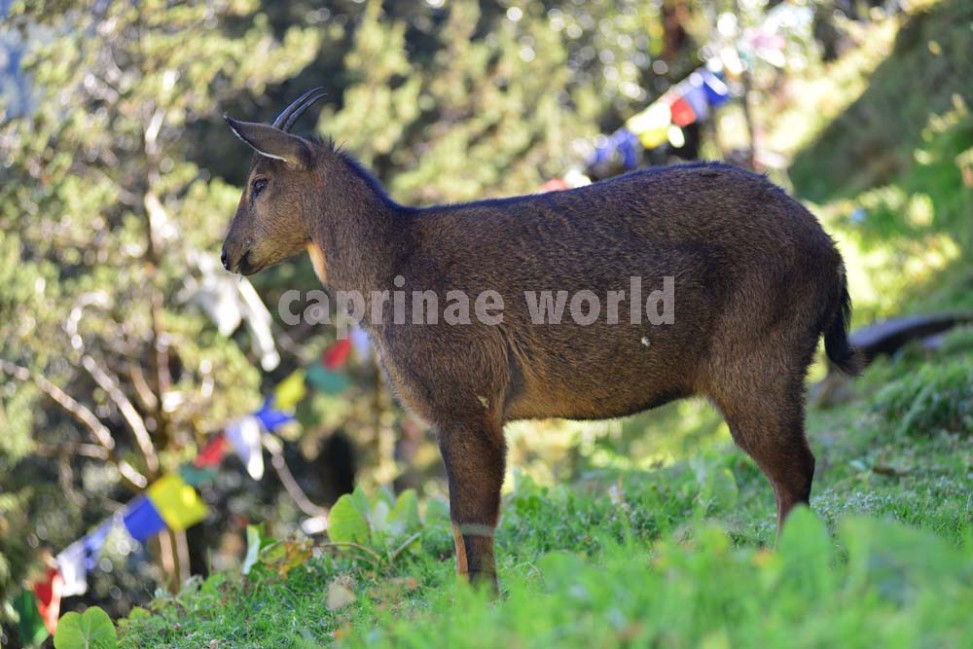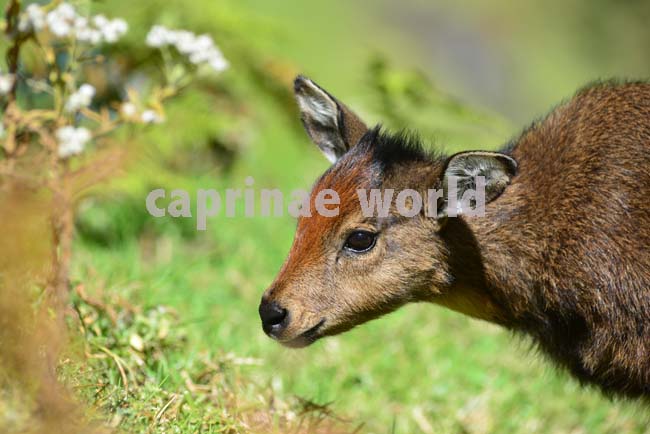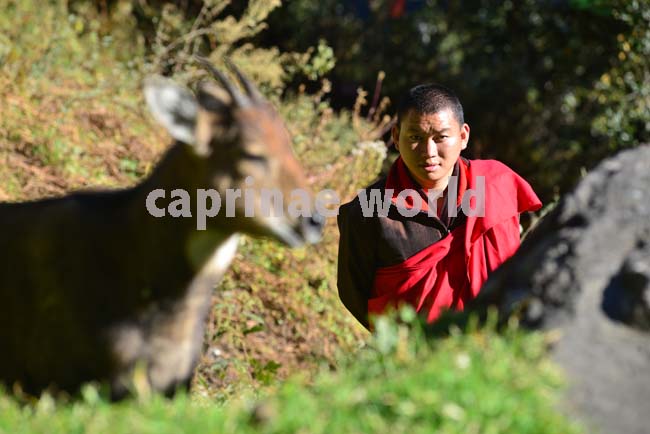The Himalayan Brown Goral is the darker, brownish variety of the the three species of goral occurring in the Himalayas.
Names
Czech name: goral východohimálajský [9]
English common name: Himalayan Brown Goral [9]
German: Osthimalaya-Goral [3]
French: Goral à queue courte [3]
Spanish: Goral marrón del Himalaya [3]
The generic name was originally spelled Naemorhedus, but the spelling Nemorhaedus, despite being an unjustified emendation, is in „prevailing“ usage and is used here as well. [3]
synonyms: Naemorhedus hodgsoni Pocock 1908
Type locality: Sikkim, India [9]
Distribution
by country: Nepal, India (North East), Bhutan, China (marginally extrem South Tibet)
In all likelihood the western border of this species’ distribution is defined by the Nepalese river Sun Kosi. In contrast to the Himalayan Grey Goral it also inhabits sites at higher altitudes, therefore it can be assumed that its range is more northerly, taking in territory in Chinese Tibet, while east of Nepal it fully connects to the mountain systems in the Indian state of Sikkim and also south to the north of Western Bengal (probably to 26°50’N). It then extends further to the east to Bhutan, where it inhabits practically the entire area more or less contiguously. In the context of the entire area, it permanently inhabits sites with the lowest altitude, see above. According to Choudhury (2007) it occasionally (during cold winters) descends to the territory of the neighbouring state of Assam. It has been observed at an altitude of 110 m amsl near the village of Mathanguri (26°49’N, 90°56’E). Further to the east it extends to the territory of the Indian state of Arunachal Pradesh, where it occurs in patches up to the Subansiri River (93°27’E), which defines the eastern boundary. [9]
General discription
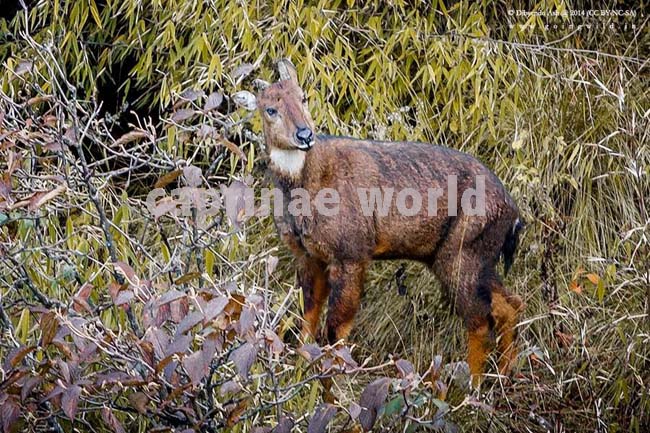
Male Himalayan Brown Goral at Pangolakha Wildlife Sanctuary, East Sikkim. Distal parts of limbs rusty in tone. Photo: Dibyendu Ash
length / head-body: 82-120 cm [3]; 95-130 cm [1]
shoulder height: 60-71 cm [3]; 66-71 cm [1]
weight: 35-42 kg [1, 3]
tail: relatively short [4], usually not longer than 7,5 [1]; distal half black [4], and not bushy [5]
back: slightly arched [1]
facial profile: concave
horn length (males): 15-23,5 cm [3]
life expectancy: 17,6 years in captivity, likely less in the wild [3]
diploid chromosome number: 56 [3]
Colouration / pelage
summer coat: light brown with a chestnut or greyish-ochre tinge. The tips of the hairs are almost invariably dark – from dark grey to black. [9]
On the body dark patterns are very conspicuous. The nuchal stripe is very broad, forming a short mane. Caudally, it smoothly changes into a significantly narrower dorsal stripe, which then narrows even further. There is a black pectoral stripe in the medial plane of the body, which begins on the chest and ends in the navel area. On the chest this stripe is usually very narrow and it grows wider in caudal direction; in some animals it begins right at the end of the throat patch, and from there it caudally extends all the way to the lighter coloured pubic region. [9]
abdominal parts: generally retains the colour of the body; some animals, however, have a clearly bordered white patch in the navel area. [9]
tail: dark brown to black from the root and usually extends in a terminal tuft. On the base of the tail, white, somewhat elongated hairs grow along the lateral surfaces, creating a light rim. [9]
limbs: The distal parts of the limbs are regularly lighter; near the hooves are almost white and gradually darken to an ochre and reddish brown colour in a proximal direction. These light lower legs end at the radiocarpal joints and the hocks, respectively. Some of the animals lack these light lower legs, in others they are deep ochre from the hooves up. [9]
A dark stripe may be formed on the dorsal areas of the thoracic limbs between the radiocarpal joints and fetlocks. A more prominent dark stripe is on the plantar surfaces of the pelvic limbs distally ending at the fetlocks; it often travels in a proximal direction to the thighs and buttocks and thus creates a not too distinct edge around the white rump patch. The dark pattern on the pelvic limbs is always more dominant than on the thoracic limbs. More distally from this pattern, a very wide dark stripe connecting the fetlock joints and hooves forms on the palmar as well as the plantar surfaces of the limbs. [9]
pubic region and perineal region:-coloured [9]
scrotum: cream or light brown colour. The medial surfaces of the limbs are either coloured similarly as the lateral surfaces, or in varying tones of ochre. [9]
head: especially the cheeks, conspicuously lighter then the body. The forehead is often a rusty chestnut and this colouring can pass rostrally to the root of the nose. The colour of the cheeks extends to the interramal part; the chin is most often brown or less frequently cream. There is often a black patch on the lower lip and chin. The colour transitions on both the head and the neck are clearly defined. The white crescents on the upper lip often blend with the light colour around the mouth. In case the animal has a dark colored lower lip and chin, a narrow white rim on the mouth can also be detected. There is no white patch on the base of the auricles. In the absolute majority of cases dark patterns on the head are entirely missing. [9]
throat patch: white; smaller than in the Himalayan Grey Goral. The throat patch extends caudally up to one third of the length of the neck and it has a rounded edge. [9]
winter coat: deeper in colour – dark brown to brownish-black. The tips of the hairs are black. The colour transitions are less clearly defined in the longer winter coat than in the shorter summer coat. In a particularly dark winter coat, the dark patterns virtually disappear, especially on the neck and spine where the colouring is the darkest. [9]
young: same colour as the adults. The colour patterns are present in all places mentioned in adults. In addition, they have a crest on the crown of the head that is the same colour as the body or a little darker. [9]
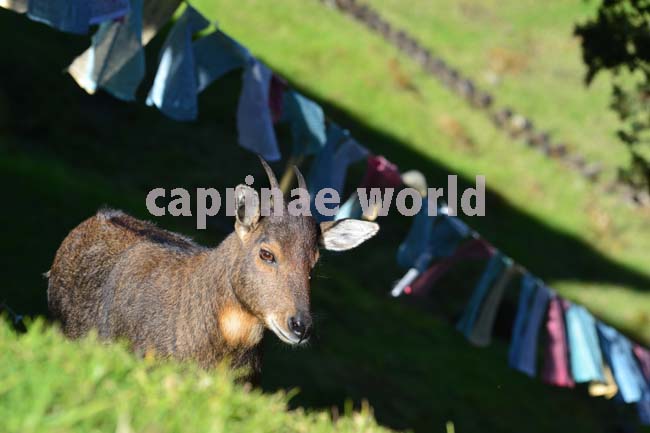
Himalayan Brown Goral from Cheri Monastery, Bhutan. Note the white throat patch, which is smaller than in the Himalayan Grey Goral, and the absence of a nasal stripe. Photo: Ralf Bürglin
Horns
Both sexes have short, backward-curving horns with irregular ridges. [3] The shape is rather straight, only the tip is slightly curved with shallow ribbing to roughly half its length. Females have conspicuously slender, straight, and shallow-ribbed horns. [9]
horn length: rarely longer than 20 cm [9]; male is 15-23,5 cm, and basal horn girth is 9-11,5 cm.
Habitat
The Himalayan Brown Goral occurs in wooded mountains at elevations of about 400-4000 m [3] / 900-2750 m [1] / 3048-4876 m [8] along most of the southern slopes of the Himalayas of northeastern India [1]. In Sikkim goral were detected most often in temperate habitats, followed by subalpine habitats. [7] Himalayan Brown Goral use precipitous cliffs and rough rocky terrain with 30-40° slopes. Their preferred habitats have a fairly dense cover of thorny shrubs and trees [3], up to the timberline. It feeds on grassy ridges and steep rocky slopes, but hides in forest or rock crevices; it seeks shelter under rock overhangs. [1] Best predictors for the occupancy of goral in Sikkim were: denser tree cover, warmer aspect and sites far away from tourist trails [7].
Mortality / Predators
Dhole, leopard, lynx, tiger, marten, wolf [5]
Food and feeding
Crepuscular and partly nocturnal in feeding acitivity. Over 90 procent of winter and summer diet is grass, but seasonally they also browse including fruits and nuts. [3] They also take leaves and twigs. [1] The Himalayan Brown Goral never feeds far from escape cover. They drink water daily, particularly after morning feeding. [3]
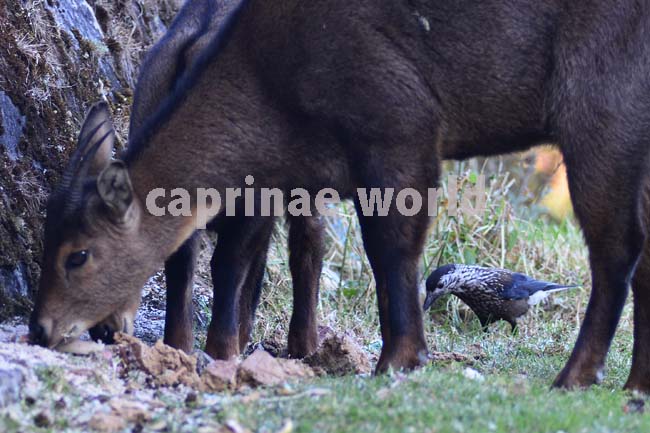
At Cheri Monastery gorals – and Spotted Nutcracker – feed on offerings like tsampa and cookies, that the monks dispose behind the walls of the monastery. Photo: Ralf Bürglin
Breeding
Territoriality: males [3]; during mating season they may occupy and mark territories of 22-25 ha.
Mating: Late September-November in the north, and from early November into December in the south [5]
Sexual maturity: 3 years [5]
Gestation: about 180 days [3], 170-218 days [5]
Parturition: from April to May [3, 5]
Young per birth: single offspring are the norm, rarely twins [3]
Weaning: 7-8 month of age [3, 5]
Activity patterns
The Himalayan Brown Goral is active in early morning on northwesterly slopes and in evening on north-easterly facing slopes. It tends to avoid open habitats when temperature exceeds 20°C [3]. In cloudy weather, they were found to take rest till late in the morning and sometimes do not come out at all. [8] In a camera-trap-study it could be proven that the species is active at night also. [7]
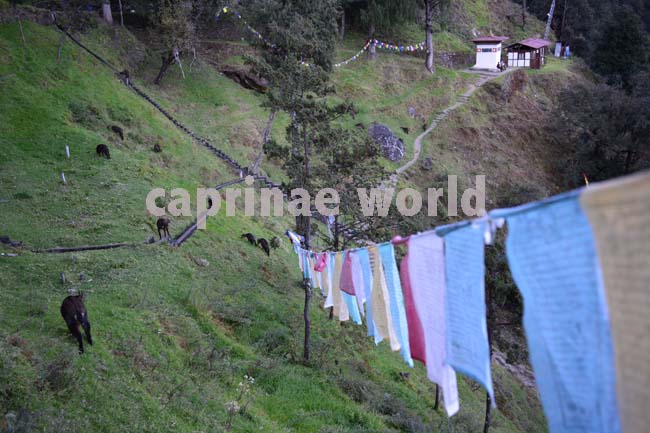
During a day in november most of the gorals at Cheri monastery stay in the shade of surrounding trees. Only in the afternoon the gorals start feeding on the shadowy meadow. Photo: Ralf Bürglin
Movements, home range and social organisation
Himalayan Brown Gorals are very nimble and move with ease through rugged topography. They are well camouflaged, making them difficult to observe. Although they can move with great speed, they often remain motionless in the face of danger. Two or three Himalayan Brown Gorals will feed in proximity [3], but adult males are usually solitary [1, 3]. Only 27 procent of females observed were solitary; 73 procent were in groups, whereas 69 procent of males were solitary and 31 procent were in groups. Female groups consisted of 2-3 individuals. Mixed groups (females plus at least one male) had 2-5 individuals, and neither sex predominated. They are rarely seen in groups larger than ten [3]. Damm and Franco (2014) give a group size of 4-12. [1] In West Bengal they generally migrate to lower valleys as low as 900 m with the onset of winter [8]. A hissing or sneezing alarm call is used to alert conspecifics in danger. [3]
Conservation Status / threats
There is no total estimate of population size. In India and Nepal the Himalayan Brown Goral seems to occur in relatively good numbers, but in China numbers are thought to be small. [1] The Himalayan Brown Goral is classified as Near Threatend on the IUCN Red List. Illegal subsistence hunting and habitat destruction and fragmentation are major threats to the species. [3] In China, poaching is probably the main threat, however poaching in Tibet is thought to be limited due to prevailing religious beliefs. [1] Status of populations is unknown due to lack of monitoring. [3]
The abundance of the Nepalese population has not yet been studied. It is probably the rarer of the two species of Himalayan gorals. The majority of recent sightings come from the protected areas to the northeast of the country, where a stronger population can also be expected. [9]
In neighbouring Sikkim, where, with the exception of the northernmost areas, it contiguously inhabits virtually the entire state. It is common in suitable habitats. In West Bengal, however, it is extremely rare (Mitra 2003). [9]
Bhutan’s population, by contrast, can be described as the largest in the entire area of its distribution. Sightings of these animals are very common in the vicinity of Buddhist monasteries, where they lose their timidity. [9]
In the Indian state of Arunachal Pradesh the Himalayan Brown Goral is one of the most frequently hunted ungulates (Chutia 2010), it can therefore be concluded that the local populations are also numerous. [9]
Trophy hunting
In Nepal the Himalayan Brown Goral occurs within some hunting reserves and was a legal game species until some years ago. Presently hunting of Himalayan Goral in Nepal is illegal. [1]
Ecotourism
Sightings of Himalayan Brown Goral are very common in the vicinity of Buddhist monasteries, where they lose their timidity. [9] Cheri Monastery, Bhutan, is one of these places, where the gorals are habituated. They feed on the meadow infront of the monastery and are fed by the monks. Tourists usually come for the monastery, but don’t recognize the particularity of the species. So do the guides. They unwittingly „declassify“ the gorals by referring to them as „wild goats“. I found only one article that praises the gorals at Cheri Monastery. [6]
Literature Cited
[1] Damm, Gerhard R. and Franco, Nicolás, 2014: The CIC Caprinae Atlas of the World – CIC International Council for Game and Wildlife Conservation, Budakeszi, Hungary in cooperation with Rowland Ward Publications RSA (Pty) Ltd., Johannesburg, South Africa.
[2] Duckworth, J.W. & MacKinnon, J. 2008. Naemorhedus goral. The IUCN Red List of Threatened Species 2008: e.T14296A4430073. http://dx.doi.org/10.2305/IUCN.UK.2008.RLTS.T14296A4430073.en. Downloaded on 16 January 2017.
[3] Wilson, D.E. and Mittermeier, R.A. [eds], 2011: Handbook of the Mammals of the World. Vol. 2. Hoofed Mammals. Lynx Edicions, Barcelona.
[4] Groves, Colin and Grubb, Peter, 2011: Ungulate Taxonomy. The John Hopkins University Press.
[5] Castelló, José R., 2016: Bovids of the World – Antelopes, Gazelles, Cattle, Goats, Sheep, and Relatives. Princton University Press.
[6] http://www.frontline.in/static/html/fl2202/stories/20050128000106700.htm
[7] Bhattacharya, Tapajit; Bashir, Tawqir and Sambandam, Sathyakumar: „Distribution, Occupancy and Activity Patterns of Goral (Nemorhaedus goral) and Serow (Capricornis thar) in Khangchendzonga Biosphere Reserve, Sikkim, India.“ Mammal Study 37: 173–181 (2012)
[8] Mitra, Sangita: „Gorals (Nemorhaedus goral hodgsoni) in Mahananda Wildlife Sanctuary, West Bengal, India.“ Zoos‘ Print Journal 18(9): 1199-1201
[9] Hrabina, Petr: „A new insight into the taxonomy and zoogeography of recent species of goral (Nemorhaedus, Bovidae, Ruminantia)“, Gazella 42, 2015, Zoo Praha

